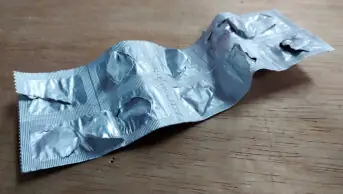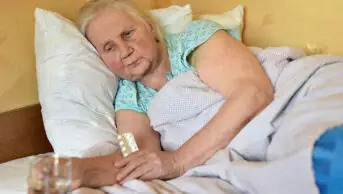
Janna Lawrence / The Pharmaceutical Journal
Rows of greenhouses sit on the campus of the John Innes Centre in Norwich, Norfolk. In one greenhouse, unruly tomato plants are tended to by post-doctoral metabolic biology researcher, Eugenio Butelli. The air is filled with that distinct, earthy scent. But these tomatoes aren’t the ordinary garden variety — some of the fruits are purple or deep indigo.
These genetically modified ‘super’ tomatoes are usually cared for by horticulturalists. But if a new strain is at a crucial stage of transformation, Butelli will look after it himself. “I treat them like children,” he says.
We want to see how bioactive each compound is and test them against a range of diseases, like cardiovascular disease or breast cancer
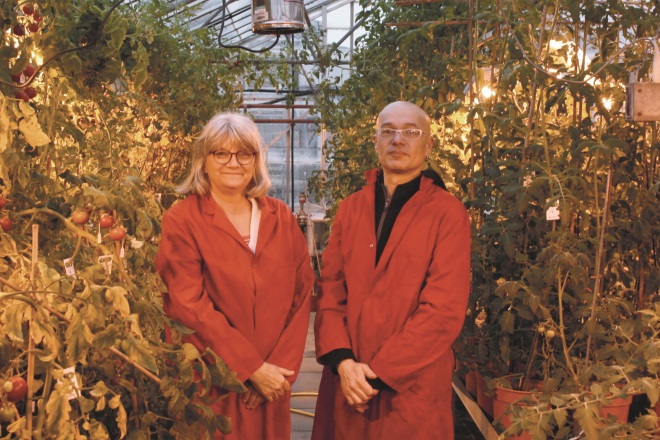
Source: Janna Lawrence / The Pharmaceutical Journal
Cathie Martin, metabolic biology lead and post-doctoral metabolic biology researcher Eugenio Butelli, at the John Innes Centre in Norwich, Norfolk
In total, there are around eight varieties of transformed tomatoes. One of these strains is producing resveratrol, found in red wine, for example. Into other tomatoes, genes from the lotus, beetroot, soy or other plants have been inserted, all producing different compounds with suspected health benefits. The goal is to see if the compounds they produce can prevent or treat disease. “We want to see how bioactive each compound is and test them against a range of diseases, like cardiovascular disease or breast cancer,” says Cathie Martin, metabolic biology lead at the John Innes Centre.
The health benefits of a balanced diet have long been espoused. Yet the evidence supporting any specific dietary supplements or vitamins is scant, prompting researchers to apply techniques used in drug discovery to better understand the activity of certain components in food. The hope is that food compounds could play an important role in a range of diseases, cancer in particular, although some data suggest individual compounds work best in tandem with other components in the food stuff.
Comparative nutrition
In 2014, the John Innes Centre unveiled the first purple tomato, engineered to produce the polyphenol anthocynanin, to much media fanfare and scientific acclaim — it won Martin and Butelli the innovator of the year award from the Biotechnology and Biological Sciences Research Council. Polyphenols are deep-coloured pigments that protect fruit and vegetables from UV radiation — they give aubergines their purple sheen and earn blueberries their name. Typically, the tomato only produces anthocynanin inside its leaves, and not in sufficient amounts to dominate the green chlorophyll. But the purple tomato has been engineered to produce it in high quantities within the fruit.
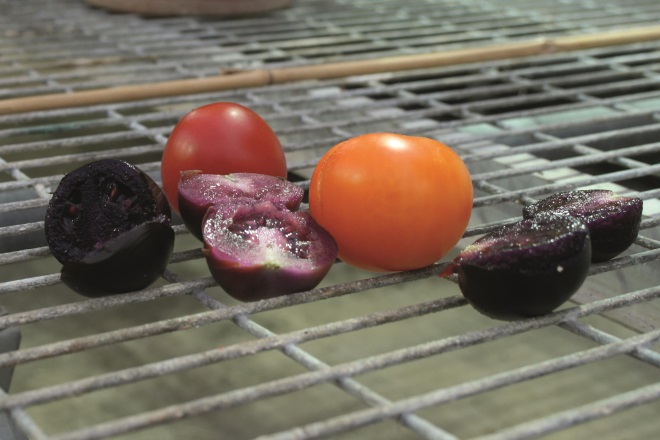
Source: Janna Lawrence / The Pharmaceutical Journal
Purple and other genetically modified tomatoes from the John Innes Centre in Norwich, Norfolk
The interest in anthocynanin stems from epidemiological studies that suggest consumption correlates with a reduced burden of cardiovascular disease[1]
. Around ten years ago, Martin, a plant biologist, began studying polyphenolic compounds because they seemed to have a protective effect on health. But many of the studies Martin was looking at were not properly controlled, comparing broccoli with peas, for example. “I thought it would be good to conduct trials with foods that differ by exactly one compound,” she explains.
By producing compounds in high concentrations in the engineered tomatoes, she hopes to single out their activity against the background of the wild-type tomato. In mice predisposed to atherosclerosis, adding 10% freeze-dried purple tomato to their diet reduced plaque lesions by 45%, compared with a 10% red tomato diet[2]
. There’s a “beautiful” dose response, says Martin. The results were presented in 2014 at the Nutrition Society’s summer meeting in Glasgow, but have not yet been published in a peer-reviewed journal. Nonetheless, Martin says she is trying to get approval for human trials.
A complex picture
At the John Innes Centre, all of the different compounds being studied in tomatoes are antioxidants, which scavenge free radicals. Antioxidants have become synonymous with healthy foods, but the real picture may be far more complex. “I don’t believe [these compounds’] primary mechanism is as an antioxidant. They have many different cellular mechanisms that modify disease,” says Martin.
Epidemiological studies that suggested damage wrought by electrically charged free radicals could contribute to the development of disease led to a flurry of observational and randomised controlled trials into antioxidants in the 1990s. The consumption of fruits and vegetables high in antioxidant beta-carotene was linked with a lower risk of lung cancer. But hopes were dashed when a large trial in men who smoked was stopped early because 18% more people receiving beta-carotene supplements got lung cancer than those taking placebo[3]
. However, the same effect was not observed in non-smokers.

Source: Edward Giovannucci
Edward Giovannucci, a researcher in nutrition and epidemiology at Harvard University in Cambridge, Massachusetts
Around 15 years ago, researchers in China and the United States embarked upon a large epidemiological study into the benefits of whole plant foods rather than isolated components. It was thought that eating five portions of fruit and vegetables each day would reduce cancer risk. “Sadly, this doesn’t seem to be the case,” says Edward Giovannucci, a researcher in nutrition and epidemiology at Harvard University in Cambridge, Massachusetts. However, these studies did find that eating five portions of fruit and vegetables a day significantly reduced overall mortality and improved cardiovascular health[4]
. Unlike cardiovascular disease, the epidemiological evidence relating to cancer risk seems to be more complex. Studies of the Mediterranean diet, high in fruit and vegetables and low in red meat, have been far more consistent and promising when it comes to risk of cancer. “It may make a difference, but it’s hard to tease out specifics,” muses Giovannucci.
Spice up your life
Despite early disappointments and confusion, researchers are still hungry to exploit the therapeutic potential of compounds contained in food to treat a range of diseases, including cancer.
In India, turmeric has been used medicinally for more than 2,000 years as a remedy for conditions such as food poisoning. Over the past 30 years, studies in animals have found that the spice can inhibit the development of skin, breast, oral and stomach cancer. Most of this biological activity is attributed to the compound curcumin, a polyphenol. “However, what you see in laboratory models doesn’t always translate to a person or population,” says Gary Asher, director of integrative medicine services at UNC Lineberger Comprehensive Cancer Centre, North Carolina, who specialises in preventive and complementary medicine.
Curcumin is freely available as a dietary supplement and seems to have a promising safety profile, says Asher. He has already conducted a number of early clinical trials assessing the safety of curcumin for prevention, which are due to be published, and the US National Cancer Institute is currently conducting a trial[5]
of curcumin in patients with familial adenomatous polyposis — which gives people a predisposition to bowel cancer — to see if it can prevent cancer developing.
There is not a lot of high quality evidence that says it’s a good idea to use supplements or nutraceuticals to prevent or treat disease, with a couple of exceptions
Between 1986 and 2011, there were more than 3,000 publications about turmeric. But Asher says the research is still in its early phases, and for other supplements, even less is known. “There is not a lot of high quality evidence that says it’s a good idea to use supplements or nutraceuticals to prevent or treat disease, with a couple of exceptions,” he says. One such exception is sinecatechins, a topical treatment for genital warts made using polyphenolic catechin compounds found in green tea (marketed as Veregen by PharmaDerm).
Asher says that there is some evidence to suggest the compounds in broccoli have anticancer properties. “But how much do you need to make a difference — can you actually eat enough of it?”
At the University of Pittsburgh, Pennsylvania, Julie Bauman is putting broccoli to the test, in the form of a supplement. Bauman is an oncologist and director of the head and neck cancer section at the university’s school of medicine. People who develop head and neck cancer are at risk of a second primary cancer and are likely to die from it, she explains. Widespread exposure of the epithelial tissue to carcinogens, like tobacco smoke, is thought to create “condemned mucosa” in the head and neck that is likely to become malignant. She is currently conducting a clinical trial at Pittsburgh using three- to four-day-old broccoli plants called broccoli sprout. The research is trying to find out if broccoli sprout can prevent, or delay, a secondary cancer developing.
Broccoli sprout extract induces the activity of enzymes in human cells that help to eliminate and protect them from the effects of carcinogens, or “detoxify” as Bauman puts it. More than 80% of this activity is driven by sulforaphane, an isothiocyanate compound found in cruciferous vegetables including broccoli, kale, and Brussels sprouts[6]
. Evidence of this detoxifying effect was found in healthy volunteers and in a placebo-controlled trial in China that studied 291 people who had high exposure to air pollution, conducted by one of Bauman’s collaborators[7]
. The theory is that this “detoxification” could protect already-damaged cells from tipping over the edge into malignancy, or at least delay it by years. “About a cereal-bowl sized portion of broccoli was protective in the China study,” says Bauman.
A grant from the National Cancer Institute is funding a trial of broccoli sprout in patients who have had a first occurrence of head and neck cancer. Over three months, 40 patients will be given escalating daily doses of broccoli sprout extract, in the form of an enteric-coated tablet, to try to establish a dose-response. Samples of mucosa will be used to track the effect of the supplement. If all goes well, the plan is to jump straight into randomised controlled trials.
The tablets used in the study are already commercially available and quality-assured, says Bauman, and she hopes that if future trials establish a benefit, doctors will recommend broccoli sprout to patients. But she would rather it wasn’t licensed as a drug because this would increase the price and limit its availability in the third world, where head and neck cancer is a huge public health concern.
I’m very interested in the idea of ‘green chemoprevention’ — naturally occurring compounds acting together
Bauman believes there are other compounds in the extract that work together with sulforaphane. “I’m very interested in the idea of ‘green chemoprevention’ — naturally occurring compounds acting together,” she says. This is also the reason why researchers at the John Innes Centre will only administer anthocynanin as part of the tomato. Sulforaphane may have independent activity, but probably works best in the context of the other plant compounds, she explains.
Sulforaphane turns on the cellular stress response pathway called nrf2, which is responsible for its detoxifying effect. But the benefits of nrf2 activation are not clear cut. In the very late stages of cancer, malignant cells can highjack this pathway to promote their own survival. This is also a paradox that applies to antioxidants. In early life, they may protect healthy cells from free-radical damage, but by the same mechanism, they may also protect cancerous cells once disease has already developed. In fact, a recent study found antioxidants may help cancer cells to metastasise[8]
.
Fighting established disease
When it comes to using vitamins or nutraceuticals to fight already-established disease, things become even less certain. “Once someone has cancer, it becomes a very different story,” says Bauman.
Turmeric, however, has promise. Biological studies indicate that curcumin has anti-inflammatory, antioxidant, antiviral, antibacterial and antifungal properties, as well as inducing apoptosis in cancerous cells. It affects multiple transcription factors and has similar activity to anti-tumour necrosis factor drugs, such as adalimumab, used to treat autoimmune diseases, and human epidermal growth factor blockers, such as erlotinib. “When you see something that affects everything under the sun, you do wonder how it actually behaves in the body,” says Asher.
There is also evidence that curcumin could help overcome resistance to the chemotherapy drug irinotecan, and so Asher is conducting a trial[9]
in patients with advanced solid cancers. Although side effects of curcumin are generally mild in healthy adults — mostly gastrointestinal discomfort and diarrhoea — in patients taking other chemotherapeutic agents, like irinotecan, that can cause life threatening diarrhoea, these effects can become more of a concern. Asher is currently trying to establish whether it is safe to give patients the two together. So far, 15 patients have been involved in the study over the past 12 months and he plans to recruit more patients before the trial ends in the next year.
Other researchers in the United States have conducted trials of curcumin in patients with advanced pancreatic cancer. Overall, it was well tolerated and in some patients had biological activity against the disease[10]
. However, one of the biggest challenges with curcumin is that it is poorly absorbed from the gastrointestinal tract, meaning it may never live up to the potential seen in laboratory studies. This is partly because it is hydrophobic — meaning it is not soluble in water. In Japan, a research group has tried to overcome this limitation and patented a nanoparticle formulation called Theracurmin, which enhances absorption. However, it is still unclear how much of the curcumin is metabolised before being absorbed and whether the metabolites have the same effects as curcumin when applied to cells in the laboratory.
With good, solid science you can look at these nutraceuticals as possible drugs
Many of the most powerful anticancer drugs come from natural products and, theoretically, compounds in food have the same potential as any other natural compound. “With good, solid science you can look at these nutraceuticals as possible drugs,” says Paul Spagnuolo at the University of Waterloo school of pharmacy in Ontario. His laboratory discovered a compound from avocados, called avocatin B, that appears to kill acute myeloid leukaemia (AML) stem cells. It targets the metabolic vulnerability of AML cells by inhibiting fatty acid metabolism, on which they rely[11]
.
For 30 years, the drug cytarabine has been the most effective chemotherapy treatment for AML. Yet mortality remains high; 95% of patients aged over 65 years die within five years. Therefore, avocatin B has the potential to be a breakthrough. But Spagnuolo is cautious about presenting his results. “I sweated bullets when our paper came out. I didn’t want people to take this research and say ‘avocado is the answer to my cancer’.” He still doesn’t know how much of the molecule is present in the fruit and cautions that, despite avocatin B coming from food, it does not mean it is safe to consume in high doses.
A polarising topic
Spagnuolo has another reason to be wary. Nutraceuticals can be a polarising topic, he says. “Some people think that it’s snake oil, not real, and then there are people with a financial interest in supplements that will push a positive message without the research,” he explains. The stigma and mistrust around nutraceuticals can make securing funding for research more difficult. But Spagnuolo says he treats the molecules like any other drug candidate.
People tend to have this idea that ‘all-natural’ means ‘safe’, when they could be doing harm
The line between food, supplement and drug is not always simple. For a patient, the desire to feel in control of what happens to their bodies can lead to them taking supplements or following dietary regimens that have little evidence to support their effectiveness. “People tend to have this idea that ‘all-natural’ means ‘safe’, when they could be doing harm,” says Spagnuolo. “We need to evaluate these compounds unbiasedly. Some may be detrimental, or interfere with treatment, but at the same time we could find supplements that can be incorporated into treatment and help kill cancer cells.”
The impact of broader nutrition during cancer treatment is another area of research that garners some scepticism. Doctors generally get little training on nutrition. “Oncologists are doubtful,” says Giovannucci. “They say we use powerful drugs, what is nutrition going to do?” Despite this, he says, there are investigations into whether metabolic differences between cancer cells and healthy cells can be exploited with changes in diet, although at the moment the evidence is not compelling enough to make any recommendations. “These are the sorts of studies we’d like to do,” he says. His team plan to follow patients newly diagnosed with cancer to see if their dietary habits affect survival.
Food and angiogenesis
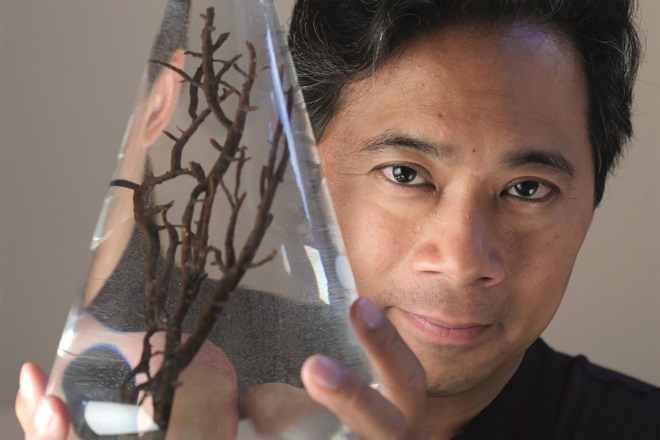
Source: Angiogenesis Foundation
William Li, president and medical director of non-profit organisation the Angiogenesis Foundation, based in Cambridge, Massachusetts
William Li, president and medical director of non-profit organisation the Angiogenesis Foundation, based in Cambridge, Massachusetts, says his interest in diet and disease was piqued because most patients ask how they can change their eating and drinking habits. “When I finished my medical training 20 years ago I couldn’t answer that question,” he says.
Li trained at Massachusetts General Hospital under Judah Folkman, a pioneer of research into angiogenesis — the growth of new blood vessels — a process that enables tumours to establish their own blood supply, making them much more dangerous. This research provided the foundation for the development of treatments such as bevacizumab, marketed as Avastin, which inhibits the development of a blood supply by targeting a protein called vascular endothelial growth factor (VEGF). “I became interested in whether food could be a source of chemicals that could starve cancer cells, i.e. be anti-angiogenic.”
The Angiogenesis Foundation is focused on leading studies that look at which foods can inhibit tumour blood supply. Li says the research has identified more than a hundred foods that can inhibit angiogenesis in the laboratory and it is now looking at correlating this biological activity with the results of large population studies.
Coincidentally, Giovannucci’s research at Harvard has already found a link. “Angiogenesis is a very strong predictor of cancer progression,” he says. After looking at almost 600 samples of prostate cancers from men, a “pretty strong” correlation was found between higher tomato intake and lower angiogenesis, potentially down to lycopene[12]
. But Giovannucci is cautious. “Sometimes people get a little bit of intriguing evidence and go off saying this is the cure — but I am certainly trying to get a grant to look at [diet], angiogenesis and cancer. Intuitively it makes sense.”
- This article was amended on 29 January 2016 to clarify that the Angiogenesis Foundation leads rather than funds studies that look at foods that can inhibit tumour blood supply. A change was also made to Li’s comment to change the number of foods that have been identified that can inhibit angiogenesis in the laboratory to a hundred instead of two dozen.
References
[1] Mink PJ, Scrafford CG, Barraj LM et al. Flavonoid intake and cardiovascular disease mortality: a prospective study in postmenopausal women. The American Journal of Clinical Nutrition 2007;85:895–909.
[2] Achterfeldt S, Traka M, Martin C et al. Do anthocyanins in purple tomatoes reduce the risk of cardiovascular disease? Proceedings of the Nutrition Society 2015;74:E85. doi: 10.1017/S0029665115001007
[3] The Alpha-Tocopherol Beta Carotene Cancer Prevention Study Group. The effect of vitamin E and beta carotene on the incidence of lung cancer and other cancers in male smokers. New England Journal of Medicine 1994;330:1029–1035. doi: 10.1056/NEJM199404143301501
[4] Wang X, Ouyang Y, Liu J et al. Fruit and vegetable consumption and mortality from all causes, cardiovascular disease, and cancer: systematic review and dose-response meta-analysis of prospective cohort studies. The BMJ 2014;349:g4490. doi: 10.1136/bmj.g4490
[5] National Cancer Institute. Curcumin in treating patients with familial adenomatous polyposis. September 2015. ClinicalTrials.gov identifier: NCT00641147.
[6] Zhang Y & Tang Li. Discovery and development of sulforaphane as a cancer chemopreventive phytochemical. Acta Pharmalogica Sinica 2007;28:1343–1354. doi: 10.1111/j.1745-7254.2007.00679.x
[7] Egner P, Chen J, Zarth A et al. Rapid and sustainable detoxication of airborne pollutants by broccoli sprout beverage: results of a randomized clinical trial in China. Cancer Prevention Research 2014. doi: 10.1158/1940-6207.CAPR-14-0103
[8] Piskounova E, Agathocleous M, Murphy MM et al. Oxidative stress inhibits distant metastasis by human melanoma cells 2015. Nature 2015;527:186–191. doi: 10.1038/nature15726
[9] UNC Lineberger Comprehensive Cancer Center. A prospective evaluation of the effect of curcumin on dose limiting toxicity and pharmacokinetics of irinotecan in patients with solid tumors. October 2014. ClinicalTrials.gov identifier: NCT01859858.
[10] Dhillon N, Aggarwal B, Newman R et al. Phase II trial of curcumin in patients with advanced pancreatic cancer. Clinical Cancer Research 2015. doi: 10.1158/1078-0432.CCR-08-0024
[11] Lee EA, Angka L, Rota SG et al. Targeting mitochondria with avocatin B induces selective leukemia cell death. Cancer Research 2015;75:2478–2488. doi: 10.1158/0008-5472.CAN-14-2676
[12] Zu K, Mucci L, Rosner BA et al. Dietary lycopene, angiogenesis, and prostate cancer: A prospective study in the prostate-specific antigen era. Journal of the National Cancer Institute 2014;106:dgt430. doi: 10.1093/jnci/djt430

